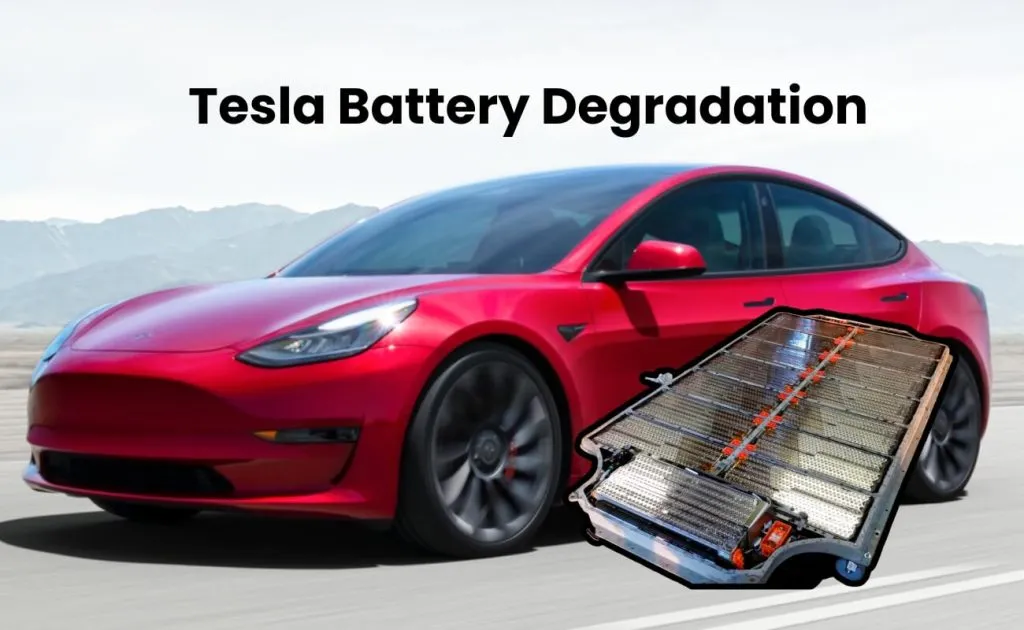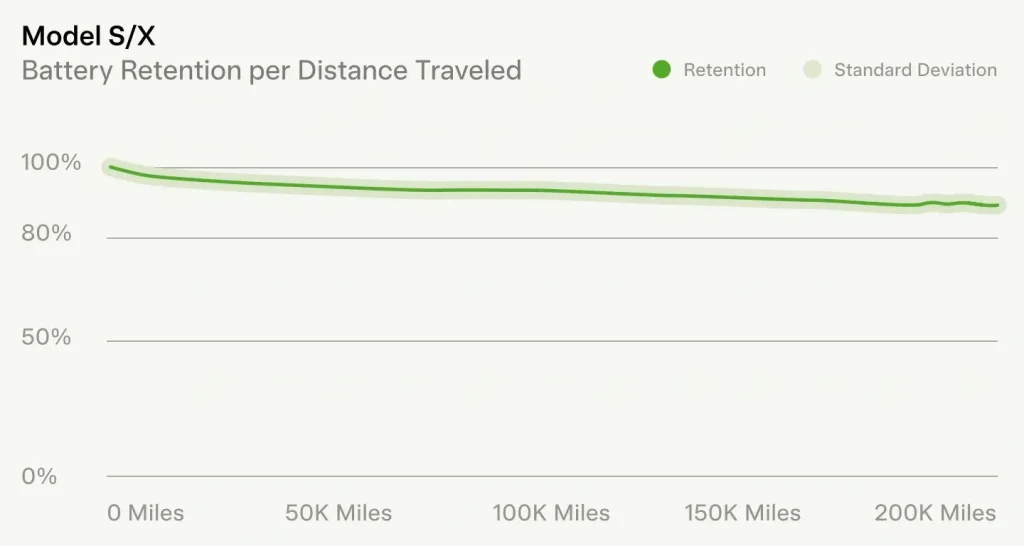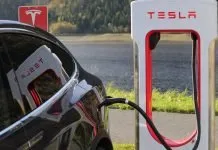When it comes to electric vehicles, people often raise their eyebrows and ask Tesla owners how long their car batteries will last before kicking the bucket. But fear not, my friends!
Tesla, the big boss of electric cars, has been gathering real-world data for over a decade, and guess what?
They confidently declare in a report that battery replacement isn’t something most of their customers need to worry about. Yep, you heard that right! With an average battery degradation of just 12% after driving a whopping 200,000 miles (that’s like going around the Earth eight times!), Tesla’s batteries are showing off their superpowers and leaving skeptics in the dust.
Here’s everything we know about the news in this post!

Table of Contents
Why EV Battery Degrades?
Electric vehicle (EV) batteries can experience degradation over time due to various factors. One of the primary reasons for battery degradation is the chemical reactions occurring within the battery cells. As the battery undergoes charging and discharging cycles, these chemical reactions can cause wear and tear on the battery’s components.
Over time, this can lead to a gradual loss of capacity and performance. The rate of degradation can be influenced by factors such as the depth of discharge (how much the battery is drained before recharging), the charging speed, and the temperature at which the battery operates.
Higher temperatures, in particular, can accelerate the degradation process, causing the battery to lose capacity at a faster rate.
Additionally, the overall lifespan of an EV battery can also be influenced by the design and manufacturing quality of the battery pack. Factors such as the choice of materials, cell chemistry, and cooling systems can impact the durability and longevity of the battery.
Battery management systems, which monitor and regulate the charging and discharging of the battery, also play a crucial role in preserving battery health. Proper maintenance of your Tesla EV and healthy charging practices, such as avoiding extreme temperatures and avoiding consistently charging to full capacity, can help slow down the degradation process. However, it is important to note that even with these measures, some level of battery degradation over time is inevitable due to the inherent nature of the chemical processes involved in storing and releasing electrical energy.
Tesla Battery Degradation Chart
In its Impact Report, Tesla provides valuable insights into battery degradation, shedding light on the long-term performance of its electric vehicle batteries. The report details the findings specifically related to battery degradation in Tesla’s Model S and Model X vehicles.

According to Tesla’s findings, the average degradation experienced by their batteries after 200,000 miles (321,868 km) of usage is a mere 12%. This means that after extensive driving distances, the battery capacity still retains around 88% of its original performance.
The earlier report suggested even better results with only a 10% loss of battery capacity in a similar report from Tesla. Such minimal degradation showcases the exceptional quality and long-term resilience of Tesla’s battery technology.
The extensive real-world data collected by Tesla provides a comprehensive understanding of battery lifespan and performance. This data encompasses a wide range of environmental conditions, driving styles, and usage patterns, making it highly representative of various scenarios and driving habits. Tesla’s analysis reveals that its batteries can withstand substantial mileage while maintaining a high level of efficiency.
These impressive results have challenged preconceived notions about electric vehicle (EV) batteries and their lifespan. Skepticism regarding the longevity and durability of EV batteries has been a common concern among potential buyers and the general public. However, Tesla’s real-world data shows that their batteries can endure significant usage without requiring replacement.
Tesla Battery Degradation
We know those folks who are skeptical about buying an electric vehicle? They often worry about what happens when the battery dies and how expensive it would be to replace. They even make sarcastic comments like,
“Oh, the battery will be dead by 60,000 miles!”
Well, guess what? New data from Recurrent Auto proves them wrong. It shows that used EV batteries are lasting much longer than these critics claim. So, those worried about the battery dying and costing a fortune? Total myths, my friends.
Electric vehicle batteries are proving to be far more durable than skeptics give them credit for. According to the recent US study the real-world data might not be as good as claimed by the automakers but is in much much favor of you buying an EV instead of those shiny gas competitors.
Recurrent, in a groundbreaking move, surveyed over 15,000 electric vehicle (EV) owners and gathered an extensive collection of battery health data. This data, the most comprehensive to date, reveals something quite surprising: EV batteries are lasting way longer than both critics and owners originally expected.
Here’s the real-world deal when it comes to battery loss of Tesla Model S and Model 3:
Tesla Model S Battery Degradation
Recurrent data on two of the most popular EVs from Tesla gives a real-world view of how Tesla’s report on degradation differs. The Tesla Model S has offered different battery pack sizes, and the study focused on the two most popular options. The largest and currently available size is 100kWh, while the other is 75kWh.
It’s worth noting that many of these vehicles were sold with unlimited Tesla supercharging, which led owners to frequently utilize this option. Although supercharging can be more taxing on battery packs compared to using a regular home EV charger, the study did not specifically measure the extent to which it contributed to range loss.
According to the comparison report the 100kWh at 96,500km or almost 60,000 miles the Tesla lost around 20% range and 23% range loss at 161,000km. Nowhere close to the Tesla degradation graph. Whereas the 75 kWh version did a lot better retaining over 96% of the original range of the EV at 60,000 miles and 8% loss at 100,000 miles.
This gets us closer to the Tesla graph we’re familiar with as it is claimed by Tesla. However, it’s important to note that the 75kWh Model S is no longer being manufactured. The new Model S vehicles now come with a 100kWh battery pack. However, it’s worth mentioning that the current 100kWh battery pack may not be identical to the original 100kWh battery found in many or most of the vehicles included in this study.
Nonetheless, this raises hope that a 100kWh Model S purchased today would experience a similar or potentially less severe range loss compared to the 75kWh version.
Tesla Model 3 Battery Degradation
Tesla Model 3 with a 75kWh battery pack did a lot better than the ones with a 50kWh battery pack on the comparison test losing only 7% range at 96,500km and 8% at 161,000km. 50kWh Model 3 kept only 84% of its original range at 96,500km and 83% of its range at 161,000km.
Tesla Model S still did better in battery degradation compared to Recurrent.
What To Expect In The Future?
Tesla owners are frequently subjected to inquiries about the longevity of their vehicle’s battery and the possibility of needing a replacement. Nevertheless, drawing upon a substantial amount of real-world data spanning over a decade, Tesla asserts with confidence that battery replacement is not a significant concern for the majority of its customers. In fact, Tesla’s batteries have consistently demonstrated impressive durability, outperforming many expectations.
Over the years, the company has made advancements in battery chemistry, cooling systems, and overall design to enhance the performance and longevity of its batteries. These ongoing efforts contribute to the exceptional durability of Tesla’s batteries and reinforce the company’s commitment to providing a reliable and long-lasting product.
The confidence Tesla exhibits regarding battery replacement stems from their extensive knowledge of battery behavior and their ability to analyze vast amounts of data from their electric vehicle fleet. This wealth of information allows Tesla to make accurate predictions about battery lifespan and dispel concerns about potential battery replacements for most customers.
The recent extensive study on electric vehicles has provided valuable insights into a question that is on the minds of many potential buyers of used EVs: How long do electric vehicle batteries actually last?
The prospect of replacing an EV battery can be daunting, with costs ranging from $5,000 to $22,000, particularly when dealing with a pre-owned vehicle that is no longer under warranty. However, the Recurrent study brings good news for those considering older EV models. It reveals that, on the whole, EV batteries are remarkably reliable and have a long lifespan. Conducted by a battery analysis company based in Seattle, the study offers reassurance to prospective buyers, suggesting that owning a used EV may not be as financially risky as initially perceived.
Bottomline
There’s a silver lining when it comes to electric cars: if the battery remains strong, they have the potential to be much more reliable than conventional vehicles. Electric motors, the heart of an electric car, are incredibly simple and can operate for over 30,000 hours.
To put it in perspective, that’s equivalent to more than 100 years of average annual driving! Unlike traditional cars, electric vehicles don’t have exhaust systems, catalytic converters, oil pumps, or those mysterious belts that mechanics always claim need replacing. This simplicity and lack of complex components give EVs the exciting potential for a long lifespan.
So, let’s keep our fingers crossed that the battery holds out, and we can enjoy the benefits of a trouble-free electric car experience for many years to come.
Tesla owners can take comfort in the fact that the lifespan of their vehicle’s battery is not a significant worry. Based on over a decade of real-world data, Tesla’s batteries have demonstrated a minimal average degradation of 12% after 200,000 miles (321,868 km) of usage. These results surpass expectations and challenge the skepticism surrounding EV battery longevity. With ongoing advancements in battery technology, Tesla continues to prioritize the durability and performance of their batteries, ensuring a satisfying ownership experience for their customers.
With an average battery degradation of only 12% after 200,000 miles (321,868 km) of usage, Tesla’s batteries have surpassed expectations and proven to be remarkably durable. This exceptional performance has reshaped perceptions and highlighted the long-term reliability of Tesla’s battery technology.


















